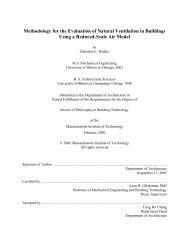CHT-08-012 Runchal_Final_Jun_08 - Cham
CHT-08-012 Runchal_Final_Jun_08 - Cham
CHT-08-012 Runchal_Final_Jun_08 - Cham
You also want an ePaper? Increase the reach of your titles
YUMPU automatically turns print PDFs into web optimized ePapers that Google loves.
1. Finite Volume Methodology2. Unification of all 2 nd order convective-diffusive systems by a generalized transport equation3. Upwind Numerical Scheme4. Pressure-Projection5. Staggered Grid6. K-ε Model for Turbulence7. Focus on turbulence energy for wall heat transfer8. Eddy-Break-Up model for turbulence-kinetics interaction9. IPSA for multi-phase flows10. 6-Flux model and IMMERSOL methodology for radiation.He was the first to formally propose that, in the context of numerical solution, all 2 nd order transportequations can be expressed and solved as a single generalized transport equation. Thus to someextent, he has achieved his life-long goal of “unifying” the treatment of fluid flow, heat and masstransport, and mechanical stresses by a single “universal” method in a “unified” manner. His otherwork on turbulence, multi-phase, solid-fluid interaction and wall distance computation has not yetseen the same popular adaption as these but he has pointed to important path-breaking research thatmay bear fruit in the future.In Newton’s words: Spalding stood on the shoulder of giants and saw farther than his peers. Heforesaw that unifying flow, heat and mass transport will lead to practical tools for engineers. Heforesaw that looking at the physics rather than the mathematics will lead to wider acceptance ofCFD tools. He foresaw that CFD - once turned into to a design tool – would revolutionizeengineering. He foresaw that there were commercial opportunities in CFD.This pattern of “innovation” by “unification” and “adoption” of other’s work with “bold insights”are the common and recurrent themes of his professional career. If I were to characterize onecommon distinctive thread in Spalding’s thinking, it is that he thinks “physics” rather than“mathematics”. Though his key contributions involve complex mathematical concepts, hisbreakthroughs have come because he looked at the physics behind those concepts. He was able tosee the “trees” because he refused to get lost in the forest of mathematical equations and looked atthe processes these equations were trying to express. He thinks like an engineer. He repeatedly asksthe question: “What can I do that will help solve a given problem”. To me this has been his keycontribution above all. He labored on with “gaps” in our knowledge about 2-phase, turbulence,boundary conditions and such like. Each time he came across an “obstacle” he found an engineers’solution. If it worked – but was theoretically a bit shaky – it was good enough to get the jobdone. He proposed things like eddy break-up for combustion when there were so many gaps in ourknowledge that no one thought you could attempt combustion with CFD!Brian to me is the best example of Richard Feynman’s famous saying: “What Do You Care WhatOther People Think?” He feels that his most distinguishing trait is that “he did what he did becausehe didn't know any better”. He quotes Virgil: "Possunt quia possunt videntur” (They can becausethey think they can). He would like to change it to: "They can because they don't know they can't."At many stages in his life he simply did not know (or more probably, did not care) that others hadalready declared a problem to be impossible or too ill-posed to be solved. And they had gone on toprove it by elaborate mathematical and physical arguments. He simply found a way to devise apractical solution to deal with the essence of the problem.-- Page 14 of 19 --
















